SIBLINGS SHOOTOUT: KTM 250SXF FACTORY EDITION VS. GASGAS MC250F FACTORY EDITION
Q: WHAT’S NEW ON THE 2024-1/2 AUSTRIAN 250 FACTORY EDITIONS?
A: The most noticeable change is to the frame, which is new on the GasGas but two years old on the KTM. Visually, the forged shock tower stands out because it now features two large relief holes—one on each side—to enhance the chassis’ flex characteristics. While other frame alterations may not be as apparent to the naked eye, they make a significant difference on the track. The thick, forged-steel backbone plates, previously welded to the top of the frame’s backbone and on the down tubes, have been slimmed down to increase flex. Additionally, the two, long, symmetrical frame tubes, visible from either side of the bike, are now made with thinner-wall tubing to enhance both torsional and longitudinal flex. Similarly, the once-solid head stays also have relief holes in them.
Lower down on the frame, the swingarm has been subtly shaved at the front where the chain slider sits, reducing chain binding. The shock linkage has been made lighter and more flexible while maintaining the same geometry and rising-rate ratio as before but with smaller, thinner link arms. The 17mm shock bolt attaching to the linkage’s bell crank has been downsized to 15mm, and the bolt at the other end of the link was reduced from 17mm to 14mm. These changes, along with the milled-out head stays, provide more feedback from the rear wheel, increasing comfort and taking the bite out of the Austrian frames. To complement these updates, WP adjusted the shock valving slightly to achieve their ideal suspension setting, while the WP XACT air fork settings are the same.
Q: IS THE GASGAS JUST A RED KTM?
A: Yes and no. Most true motocross enthusiasts just see the three Austrian brands as orange, white and red KTMs. In one sense, the MXA test riders agree with the majority opinion here. They are incredibly similar machines that platform-share their most significant parts (i.e., engines, frames, suspension, electronics) with KTM; however, once on the track, the three Austrian race bikes do a good job of differentiating themselves. The changes the engineers made to each brand do result in contrasting performance parameters.
The KTM is the “race-ready” brand. The orange bikes have all the bells and whistles needed to go fast. Their suspension is stiffer, the powerplant more responsive and the airbox flows more air, which improves throttle response.
Husqvarna is a “legacy brand.” For the white bikes, the marketing pitch, suspension setup and broad powerband are tailored to Vet riders, many of whom still remember the heyday of Husqvarna of Sweden. In a bold move, Husqvarna shortened the suspension travel at both ends to make the seat height 1 inch lower and, correspondingly, it feels slightly softer on the track (even though WP insists the internal fork and shock settings are the same as on the KTM). The Husky shares all of KTM’s bells and whistles (i.e. Brembo brakes and clutch, map switch with traction control, launch control and QuickShift). As has become de rigueur for KTM, Husqvarna and GasGas engine management, the Husky airbox is closed off more than the KTM airbox, creating a slightly muted throttle response from low to mid that works well for Vet and Novice riders.
GasGas is the “fun brand.” The red bikes are positioned as the exciting new youth brand. Their tagline is “Spice it up,” and they target a younger audience with their marketing. The GasGas retail price is also meant to attract a younger audience, as buyers can save a few dollars by going with a stock GasGas. But, to offset the savings, you won’t get all the KTM and Husqvarna frills. You get BrakTec brakes and clutch hydraulics instead of Brembo. You don’t get two maps, traction control, launch control or QuickShift, and you get an even more closed-off airbox than on the orange and white brothers—once again, hindering initial throttle response.
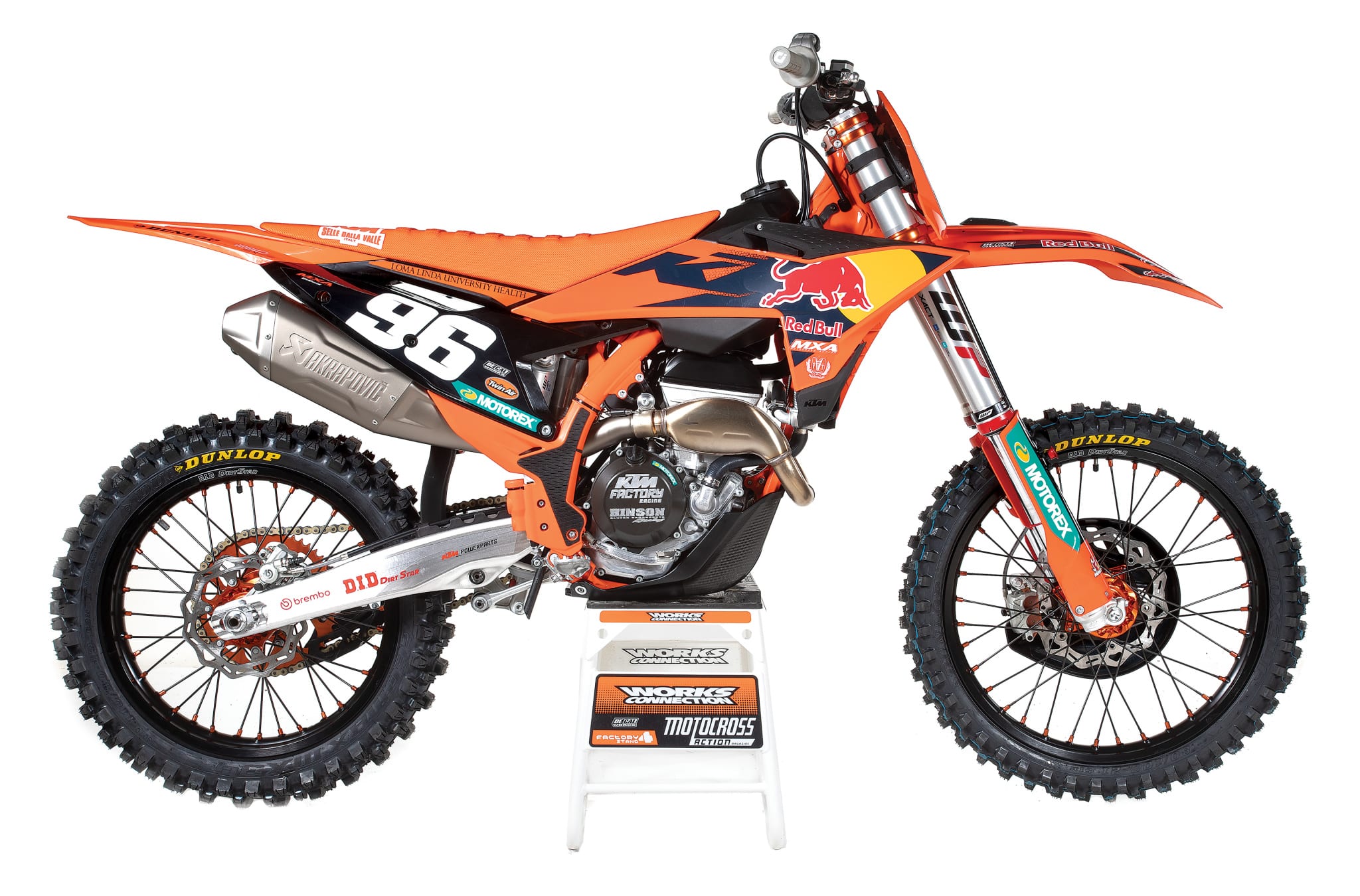 The 2024-1/2 KTM 250SXF is an early release of the 2025 model, only with an Akrapovic muffler and a few PowerParts items.
The 2024-1/2 KTM 250SXF is an early release of the 2025 model, only with an Akrapovic muffler and a few PowerParts items.
Q: WHAT ARE THE DIFFERENCES BETWEEN THE GASGAS MC250F AND KTM 250SXF FACTORY EDITIONS?
A: On the normal production-line GasGas and KTM machines, we can roll off a litany of noteworthy differences between the red and orange specs. This time, with the Factory Editions, we can’t. These two bikes are almost identical—apart from their identifying colors and bodywork. Factory Editions are produced in limited quantities and brought to the U.S. primarily so the factory teams can race next year’s bike this year. That is a lot of expense and effort to go to for a small handful of factory riders. Because the AMA rules require that 400 units be homologated before they can be raced, the average local racer can get one of these special racers also.
Understandably, if they aren’t making any significant changes to the next model yet, they won’t even make the 400 250cc Factory Edition 250Fs. For example, KTM and Husky didn’t make any major updates between 2023 and 2024, so they didn’t go through the hassle of assembling 2023-1/2 Factory Edition 250 models—just 450s. However, since the 2025 model year is very important to the Austrian brands, and they have gone to the effort of developing a new frame for 2025, they fired up the production lines late last year to build limited runs of six Factory Edition models, both 250 and 450 versions of the KTM, Husky and GasGas.
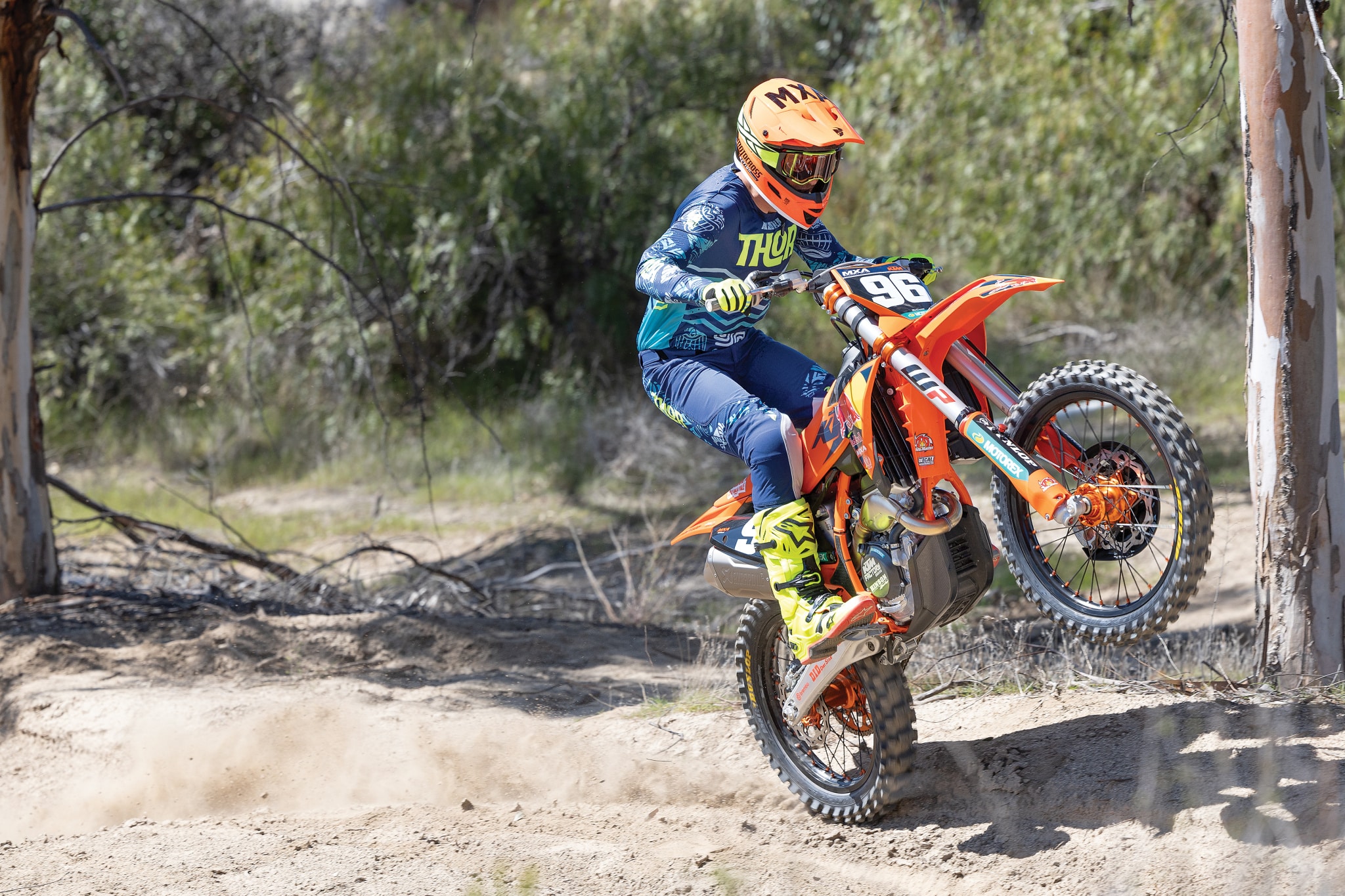
The Austrians go all out to make their stock production bikes seem unique, but they don’t make the same effort to differentiate their Factory Edition bikes. Why not? Because they only make a special production run of 400 of each of these bikes. Plus, the factory teams use full-length suspension (not the shortened components that come stock on Huskys) and every 2024-1/2 Factory or Rockstar Edition gets map switches and Brembo brakes and clutches (not the BrakTec components that come on GasGas). Thus, they see no problem in offering Factory Edition models that are nearly identical to each other. Factory Editions, regardless of brand, have the same exact suspension valving and the same exact ECU mapping and electronics. Additionally, the KTM and GasGas Factory Editions have the same Akrapovic mufflers (Husky has FMF), and they have the same brake and clutch hydraulics.
Here’s a list of the only real differences.
(1) Bodywork. The GasGas MC250F and KTM 250SXF Factory Editions have different fuel tanks (KTM’s is 1.9 gallons and GasGas’ is 2.0 gallons) designed to work with each bike’s unique radiator shrouds. The GasGas MC250 Factory Edition’s radiator shroud, airbox cover and side number plates are one molding that stretches from the radiators all the way to the rear fender. The KTM 250SXF Factory Edition has separate radiator shrouds, airbox cover and side number plates.
(2) Frame color. The KTM frame is powdercoated in factory orange and the GasGas is cherry red.
(3) Seats. To fit with their unique plastics, KTM and GasGas each have their own seats with unique seat bases and unique covers. The KTM has a Selle Dalla Valle orange gripper seat cover with ribs, and the GasGas has a red and bluew GasGas factory racing gripper cover.
(4) Handlebars. The GasGas handlebar is 12mm taller than the KTM bars, with a bend replicating the Renthal 928 bend.
(5) Aesthetics. The wheels, triple clamps and rear sprocket are both the same, just in brand-specific colors.
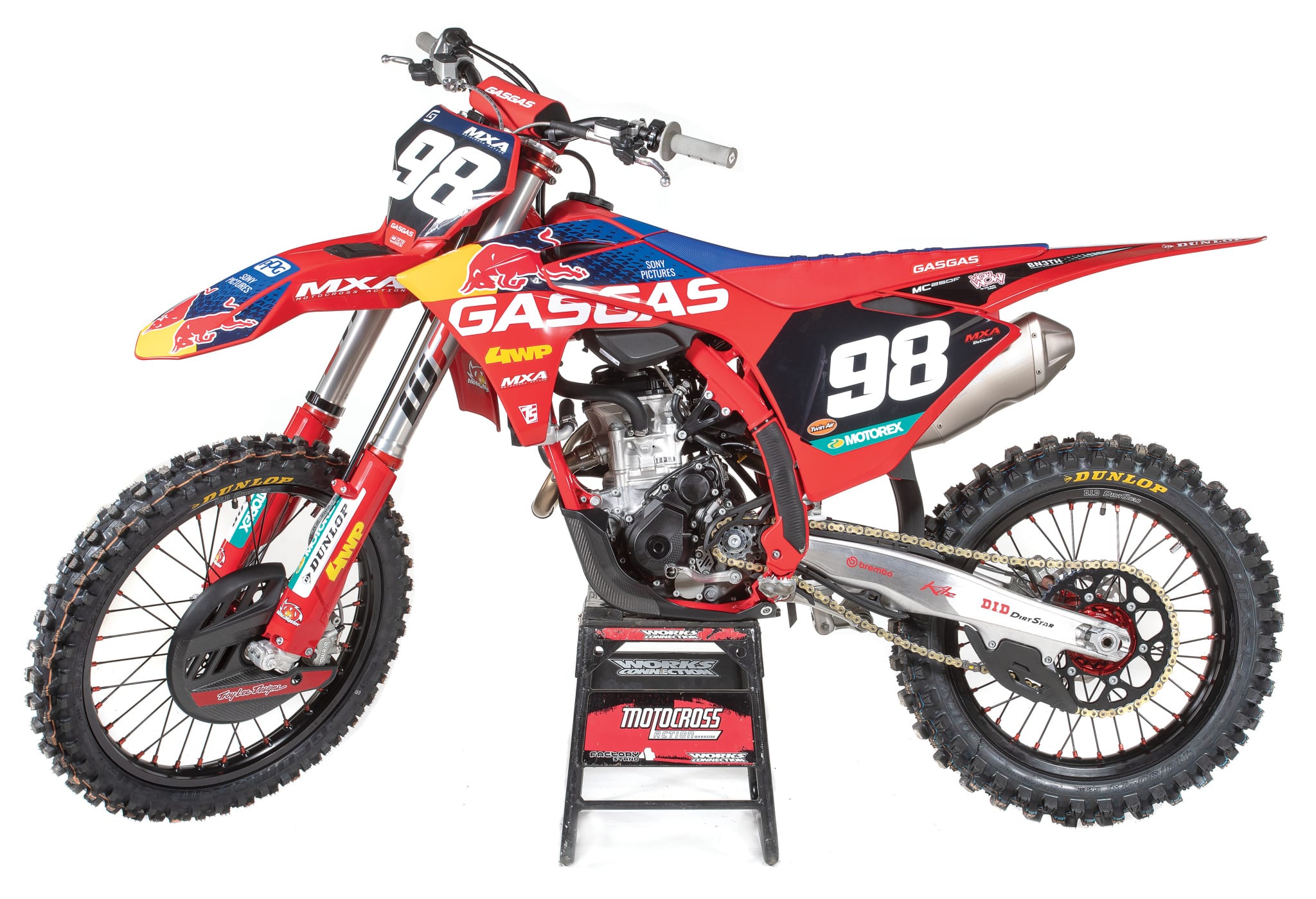 The MC250F Factory Edition is a carbon copy of the KTM, only with a choked-up airbox.
The MC250F Factory Edition is a carbon copy of the KTM, only with a choked-up airbox.
Q: HOW DO THE 2024-1/2 FACTORY EDITIONS RUN ON THE TRACK?
A: The KTM and GasGas 250 Factory Edition engines run very similarly. The KTM does breathe better and therefore provides more “snap” at the first crack of the throttle. Otherwise, they feel very much like twin brothers when they are in motion. Both engines have expansive linear powerbands, and they peak well above 13,000 rpm. This means that the rider must be willing to wring the engine out to get the most out of it. Because our test riders switch between all displacements and brands, we constantly have to remind them not to shift until the cows come home when on the Austrian 250 four-strokes. If you ride a 350 or 450 often, you can get comfortable riding lower in the rpm range and short-shifting. Sure, the KTM and GasGas 250cc engines are strong enough to still pull you if you do shift early, but you won’t be getting your money’s worth. There is a whole new world of power available for riders who aren’t afraid to break the 13,000-rpm barrier.
Additionally, the new 2024-1/2 250Fs run cleaner than before. The Austrians didn’t publicly announce it, but they fixed the traction control map on the 250Fs, and it made the “TC” setting usable again. When this generation came out in 2023, the traction-control map detuned the engine horrendously. It was no longer monitoring spikes in rpm to manage rear-wheel traction; it simply detuned the power so much that the bike sounded like it had electrical issues. Now, traction control has been fixed, and it’s worth trying again. Also, the KTM and GasGas Connect apps allow you to adjust how strong or how light the traction control is, which is a nice touch.
Bonus tip: You can remove the insert from the Akropovic muffler to make the bike slightly snappier coming out of corners, but of course, it makes the bike louder, too. There is a small rubber plug underneath the muffler tip that must be removed before you can stick an Allen key tool in there to loosen the bolt and remove the insert.
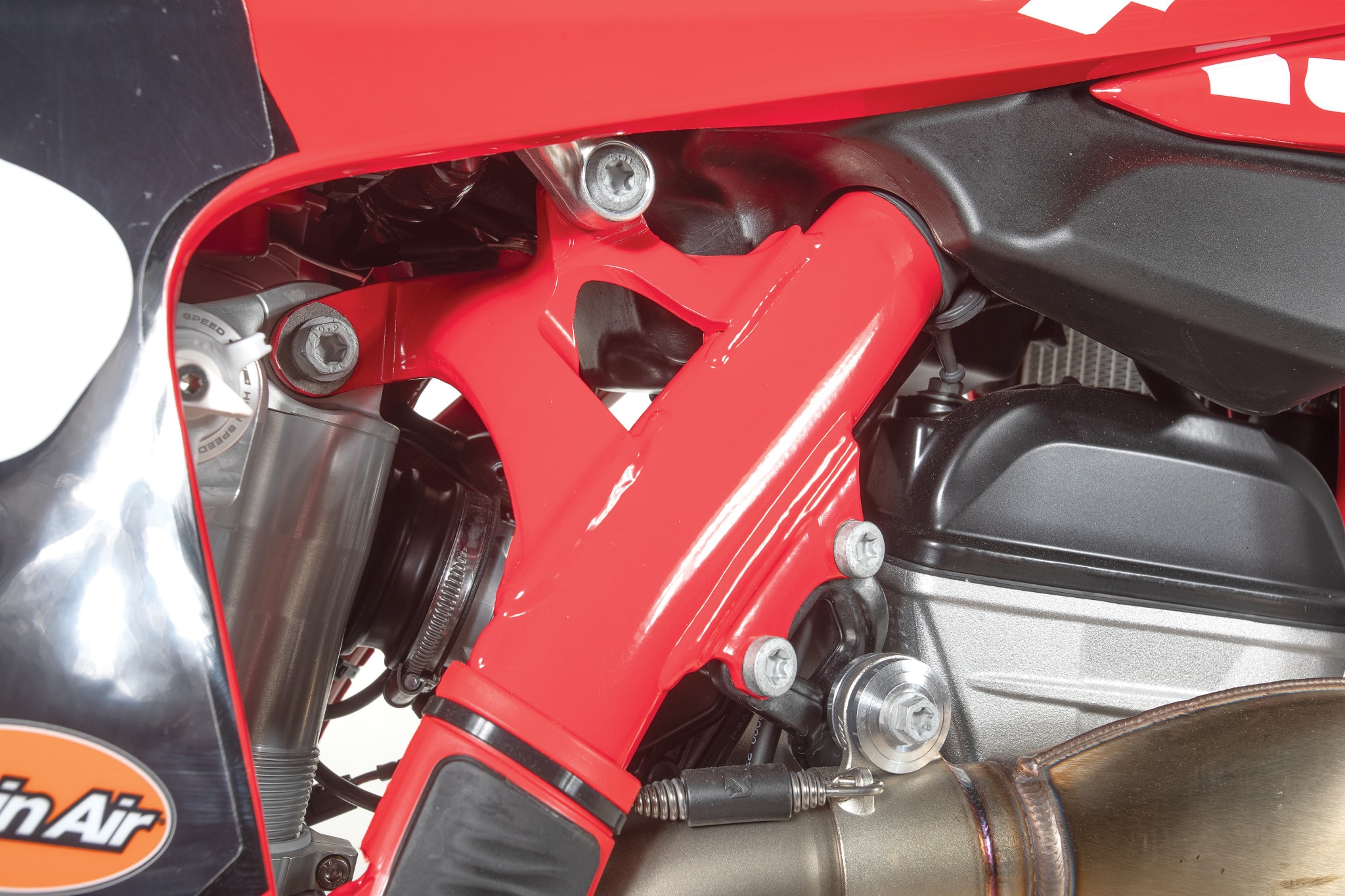 The cutout on the shock tower is the most visible change to the new 2024-1/2 and 2025 frames.
The cutout on the shock tower is the most visible change to the new 2024-1/2 and 2025 frames.
Q: HOW DO THE NEW FACTORY EDITION 250Fs HANDLE?
A: The 2023 and 2024 models were on the rigid side, and they took a while to break in. We recommended 10 hours, but truthfully, the 250 four-strokes were easier to break in than the heavier and stiffer-suspended 350 and 450 machines. Still, the frames were on the stiff side, and we appreciate the update to the new frame. It cuts break-in time down by 90 percent (before it needed 10 hours; now it needs about an hour), and it has improved comfort on the track. Our test riders love how planted the wheels are. The throttle, brakes and suspension offer a confidence-inspiring experience, making you feel very connected to the track.
Of course, the air forks still need to be closely monitored, especially on a hot day, because the pressure will go up. We had great success with Dal Soggio’s FSR-48 complete spring fork, using it on multiple Austrian bikes throughout the last year. The springs bring out a level of plushness and comfort that is tough to find with air.
Q: HOW IS THE NEW BLUETOOTH CONNECTIVITY UNIT?
A: The new KTM/Husqvarna/GasGas Factory Editions feature new Connectivity Units that enable riders to link their smartphones to their bikes for personalized mapping, lap times and engine monitoring. KTM initially launched a Bluetooth connectivity unit on the 2021-1/2 Factory Edition models, but it had bugs and never made it to the 2022 production bikes. On a side note, the factory that made an important component of the unit had burned down, hampering production. It wasn’t all a loss, though, as the previous system had some flaws.
The new Connectivity Unit Off-Road (CUO) app quickly propelled the Austrian group into the technological lead in motocross electronics. It offers new levels of data acquisition and customization that have never before been available to the public. The new app allows riders to adjust throttle response, engine braking, traction control, launch control and even quickshift sensitivity between gears. Furthermore, the new Factory Editions and 2025 models are equipped with a GPS, G-force sensor, Wi-Fi transmitter and data collector, all compatible with LitPro software. This software tracks various metrics, including lap times, segment times, G-forces, airtime, average speed, distance jumped, and theoretical best possible lap.
What sets this system apart from a standard LitPro is its integration with the bike’s ECU, providing additional data such as the rider’s rpm range, shifting frequency throughout a lap, coolant temperature and more. Connecting to the bike and customizing the maps is straightforward. When uploading a map, the created map is assigned to the green map button (map 2), while the white map button (map 1) turns into a milder version of the created map. Unfortunately, it’s not possible to customize and upload both maps individually (as with Yamaha).
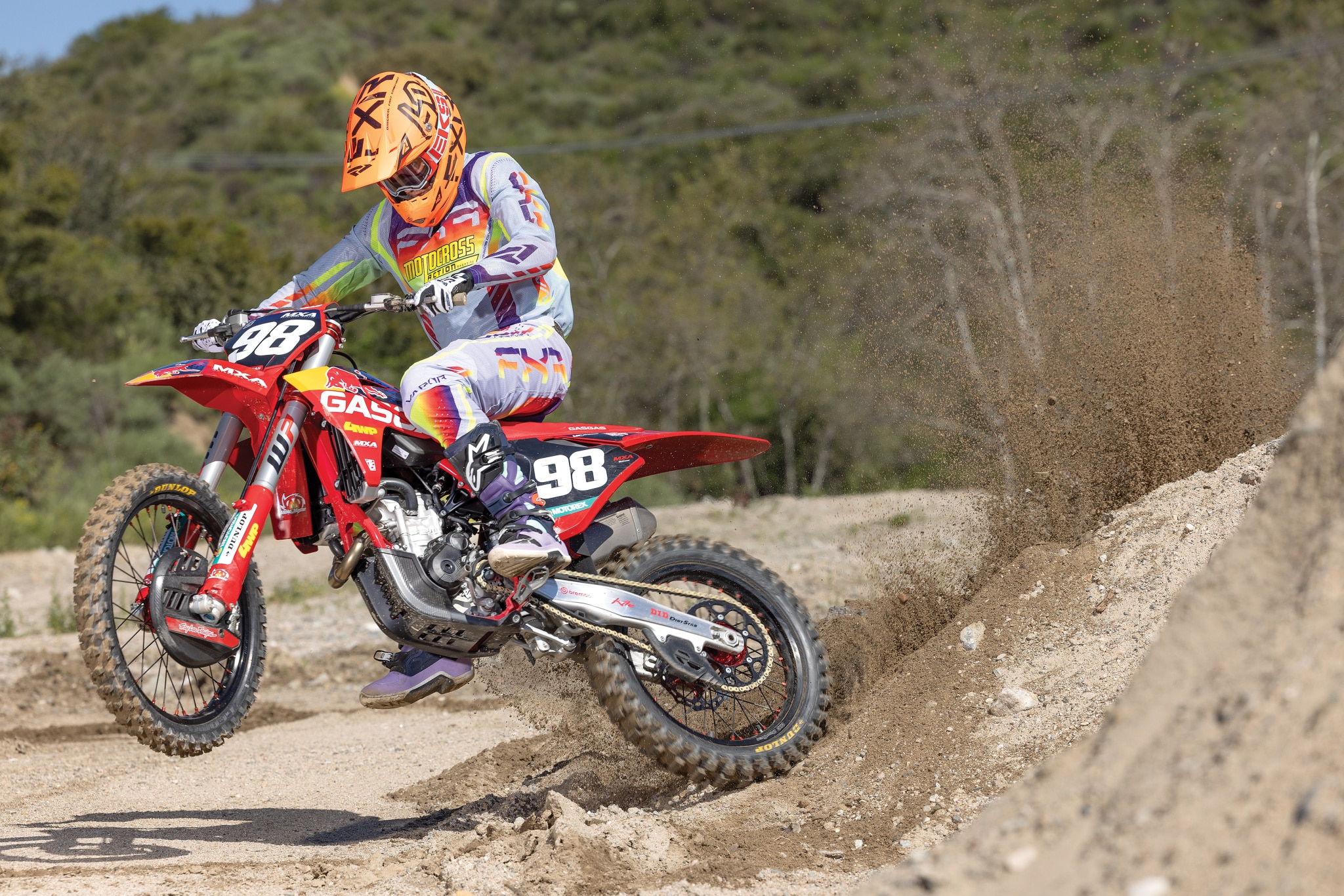
Q: ARE THE KTM 250SXF AND GASGAS MC250F FACTORY EDITIONS WORTH THE EXTRA MONEY?
A: Yes and no. It depends on what kind of rider you are and what you demand from your race bike. The 2025 KTM and GasGas 250Fs will come with all the major performance upgrades of the Factory Edition models, such as the new frame and new linkage. They will also be compatible with the new CUO system (just like the 2023 and 2024 models), but they won’t come stock with the GPS unit mounted in the front fender or the data acquisition transponder on the right fork leg. That’ll be an extra $249 if you want to buy the hard-ware needed to connect your phone to your bike and use all the cool new features that come with it.
Also, the 2025 models won’t come with the Factory Edition’s skid plates (worth $209), Akrapovic mufflers (worth $892), CNC-machined Powerparts split triple clamps (worth $550), the Powerparts factory wheel set (worth $1029), WP start device (worth $104) and more. These accessories alone are valued at $2800. Plus, you can’t buy replica Red Bull graphics anywhere, and for some riders that’s worth some extra dough, too.
Be forewarned, the 2025 GasGas MC250F will be spec’ed with Braktec brakes, levers and calipers and a Braktec hydraulic clutch slave unit. They aren’t terrible, but nothing compares to Brembo. The stock GasGas also won’t have a map switch, and it will have softer suspension settings. Overall, the $11,349 MSRP is steep for these two bikes, but maybe it is worth it for someone who wants a GasGas but still wants the Brembo hydraulics, stiffer WP valving and the full suite of electronic aids. Both bikes do come with the $249 CUO system, which adds a lot of value for riders who like to geek out about their lap times and want to customize their ECU mapping.
The Factory Edition KTM 250SXF is $1200 more than MSRP on the stock 2024 KTM 250SXF, and the GasGas MC250F Factory Edition is almost $2000 over the 2024 MC250F price. Still, the extra money buys you the much-improved frame and a healthy list of upgrades.
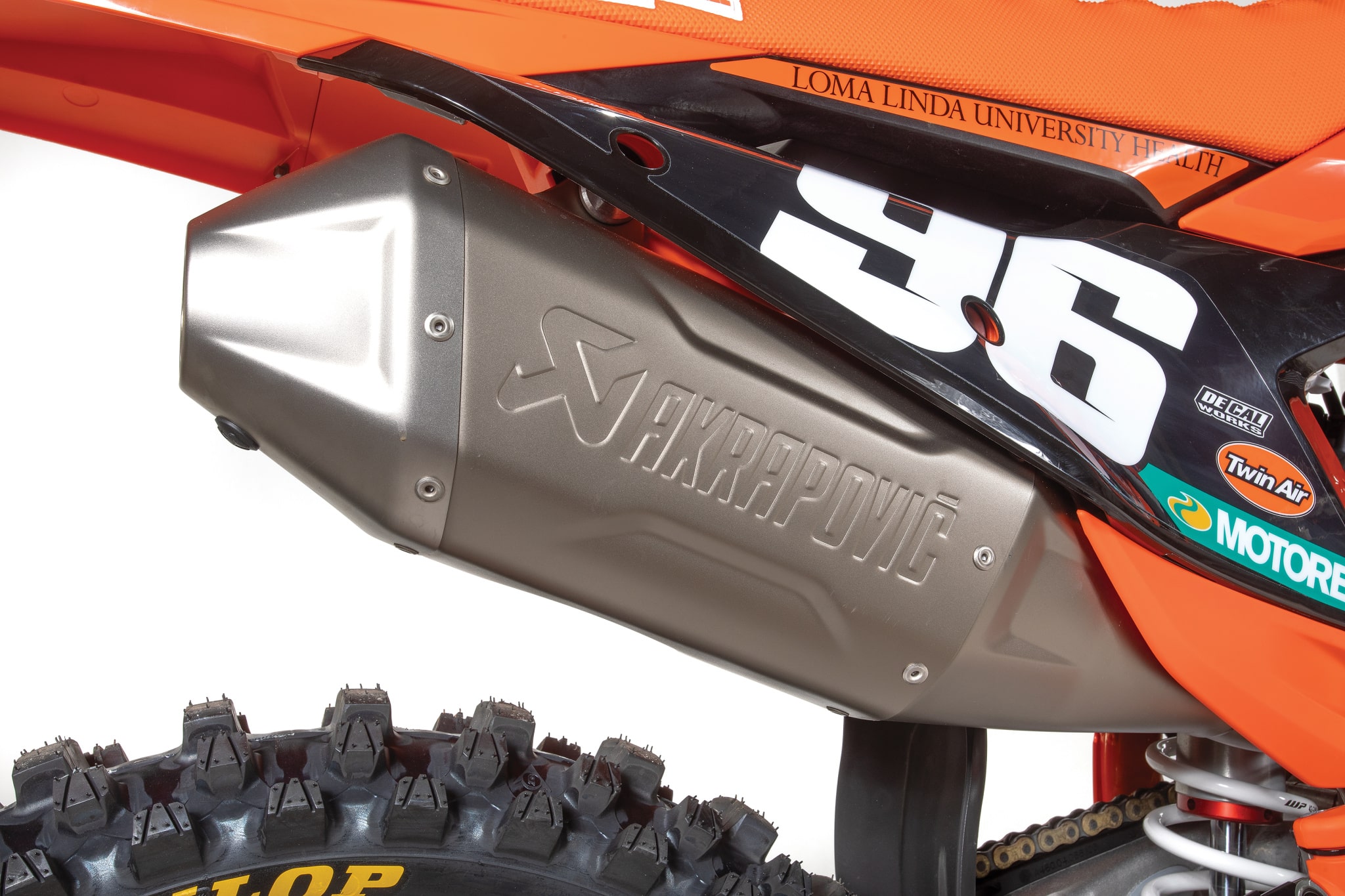 Both bikes come with an Akrapovic muffler and stock header.
Both bikes come with an Akrapovic muffler and stock header.
Q: WHAT DID WE HATE?
A: The hate list:
(1) Distinction. We understand the business reasons, but we still wish the engineers had separated the GasGas and KTM a little more instead of just making two of the same bike in different colors.
(2) Start/stop buttons. These are fine for most riders, but it can be hard to find the button quickly when you crash and you’re trying to get going again. We press the map switch button and turn the bike off accidentally all the time. Nihilo Concepts makes a kit that moves the start and stop buttons back to their rightful places.
(3) Radiator cap. The plastic radiator cap is a pain to remove. Nihilo Concepts also has a fix for this. They make a removal tool that helps.
(4) Spokes. The spokes come loose. Keep a close eye on them, especially when breaking them in.
(5) Chain slack. You need 70mm of chain slack. That’s about four fingers under the chain at the back of the buffer pad. We hate how loose it’s supposed to be nowadays.
(6) Muffler. The Akrapovic muffler that comes stock is different from the full Akrapovic system you can buy. The Akrapovic header has a smaller diameter than the stock header, thus it won’t mate up to the Akrapovic muffler that comes stock on this bike. If you want an Akrapovic header, you have to purchase a completely new system.
(7) Front brake. Our test riders don’t notice a performance difference between the semi-floating front brake rotor on the Factory Editions and the solid-mounted rotors on the stock models; however, they do feel the difference in the pits when they grab the brake and the front wheel rocks back and forth. Also, the front brake rotor guard is cool, but we normally remove it to get more airflow to the front brake.
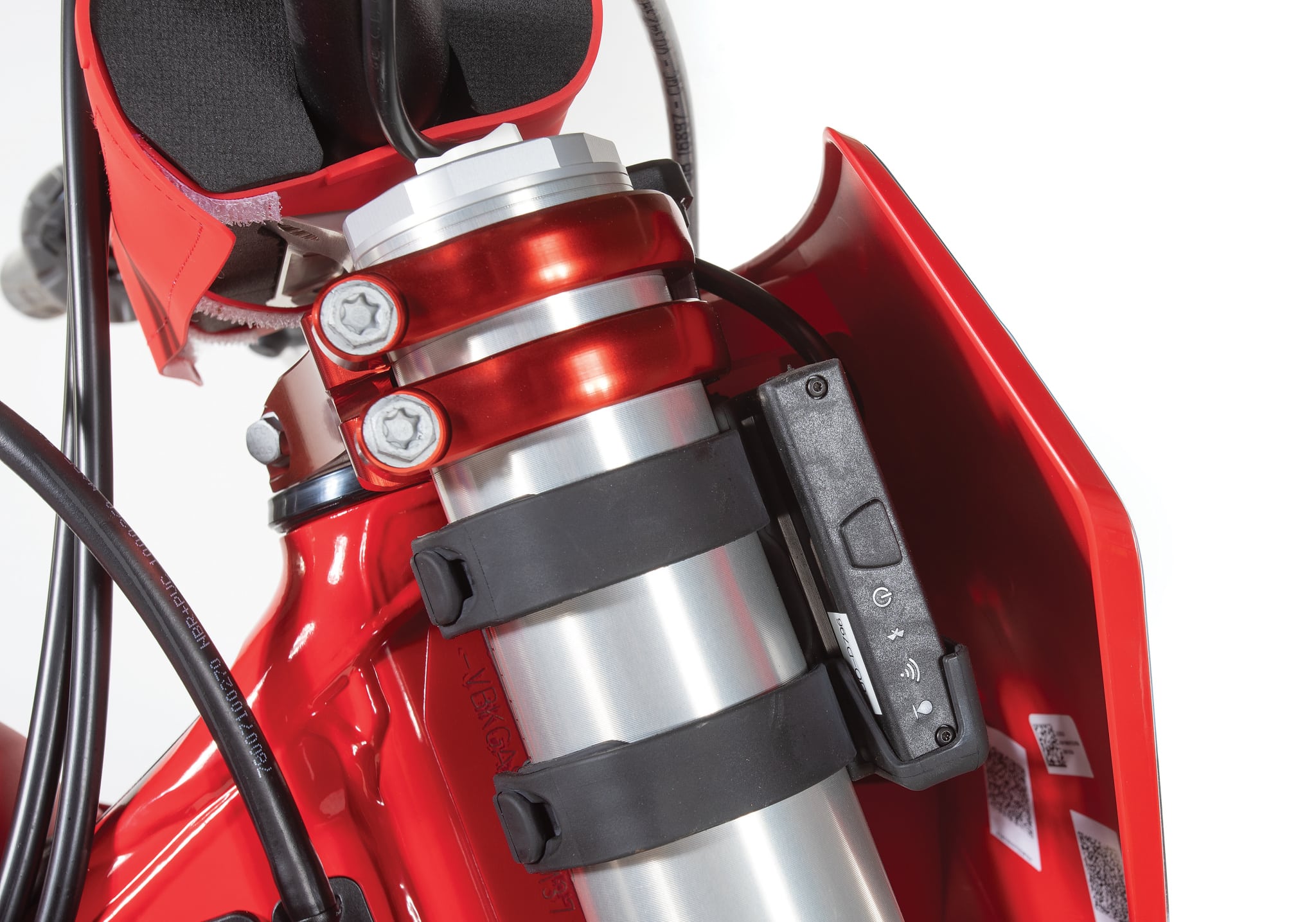 This is the transponder that allows smartphone connectivity.
This is the transponder that allows smartphone connectivity.
Q: WHAT DID WE LIKE?
A: The like list:
(1) Value. We like that they’ve thrown practically the entire PowerParts catalog at these bikes. They’re expensive, but there are a lot of value-added parts incorporated into the Factory Edition models.
(2) Start device. It’s nice that these bikes come “ready to race” with the WP start device.
(3) Shock collar. We’ve been thanking the Austrians ever since this new shock collar came out on the 2023 models. It’s more durable than before, and it’s easier to use than Showa and KYB collars.
(4) Factory skid plate. It’s nice that the steel frame comes with threaded bolt holes to mount the skid plate.
(5) No-tools clickers. We love that we can adjust every suspension clicker (except the shock rebound clicker) by hand.
(6) Brakes. Brembo brakes are the bee’s knees. We love them.
(7) Clutch. KTM’s diaphragm clutch, Belleville washer spring and steel clutch basket result in a clutch that lasts twice as long as any other brand’s clutch, even the ones that copy the KTM design.
Q: WHAT DO WE REALLY THINK?
A: Overall, the new 2024-1/2 KTM 250SXF and 2024-1/2 GasGas MC250F are two big steps ahead of the 2024 models. They’re more user-friendly, thanks to the softer and more resilient frames, and come with super-high-tech ECU systems that enable the rider to analyze data and customize the ECU mapping. On many model years, the Factory Editions are just stock bikes with a lot of glitzy aftermarket parts. This year, the Factory Editions come with all the benefits of next year’s bike, along with some useful protection and performance parts in the bundle. The 2023–2024 models are no slouches, but the 2024-1/2 models are two steps ahead.


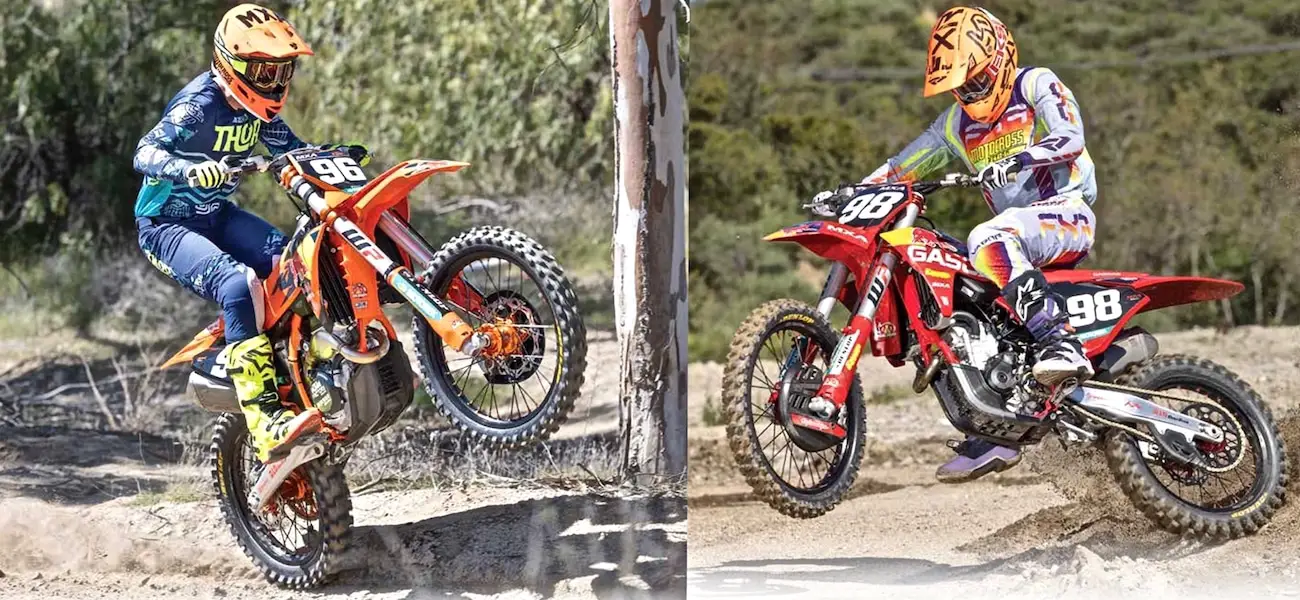
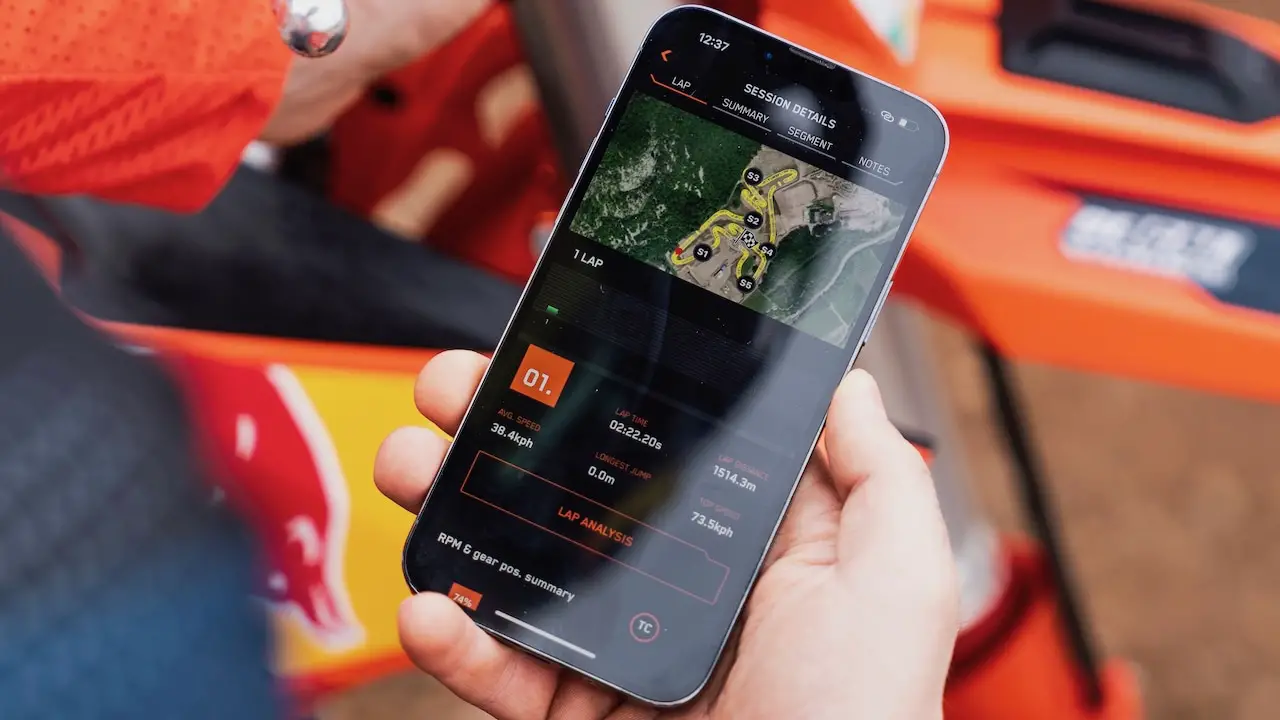





Comments are closed.